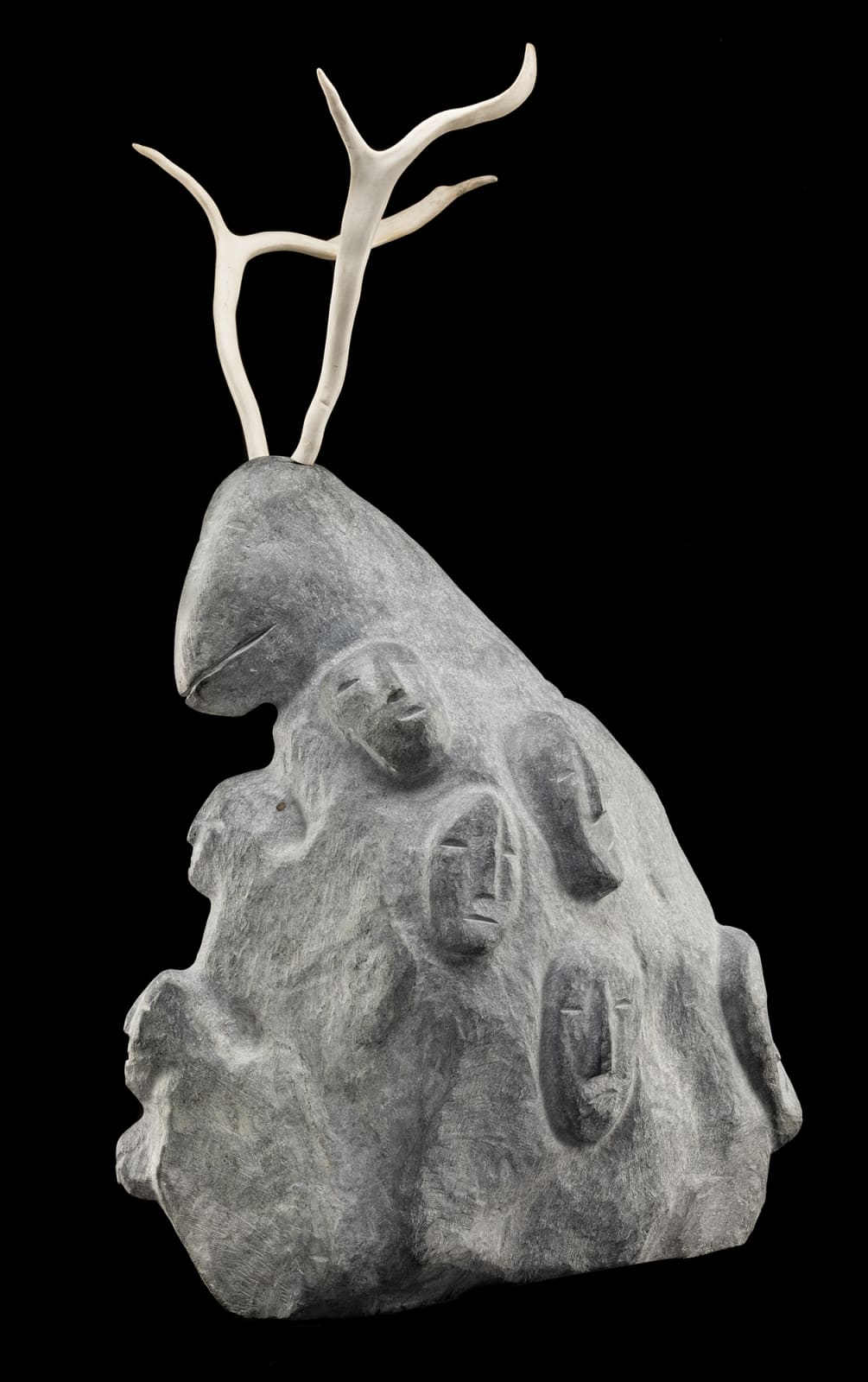-
Artworks
LUKE ANOWTALIK (1932-2006) ARVIAT (ESKIMO POINT)
People of the Caribou, c. 1999stone and antler, 36.5 x 21 x 11 in (92.7 x 53.3 x 27.9 cm)
unsigned.
LOT 128
ESTIMATE: $8,000 — $12,000Further images
Luke Anowtalik belonged to the Ihalmiut (Caribou Inuit) who lived inland near Ennadai Lake. Born at Ennadai, he was orphaned as a boy. After being cared for by qallunaat in...Luke Anowtalik belonged to the Ihalmiut (Caribou Inuit) who lived inland near Ennadai Lake. Born at Ennadai, he was orphaned as a boy. After being cared for by qallunaat in Churchill, Manitoba for two years, he trekked by dogteam to Ennadai Lake by himself, searched camp after empty camp, went snowblind, and was finally rescued and adopted by camp leader Andy Aulatjut and his family; Anowtalik eventually married Aulatjut and Nutaraaluk’s daughter Mary Ayaq. The family is frequently mentioned in Farley Mowat’s books People of the Deer (1951) and The Desperate People (1959), which chronicled the starvation and bungled relocations of the Iharmiut to Eskimo Point (now Arviat) and other coastal communities. Anowtalik and Ayaq were also featured in a Feb. 27, 1956 Life magazine article about the “Caribou Eskimos” in which they “showed off their Mesolithic skills.”
The inland Ihalmiut were labelled the “Caribou Inuit” because, unlike coastal Inuit groups, they relied almost entirely on the migrating herds of caribou for every aspect of their material existence. For Anowtalik the connection between humans and caribou was a powerful one, both physically and spiritually. He hunted caribou as long as he was able, and created lyrical and charming antler sculptures his entire career. Anowtalik’s late-career drawings frequently feature caribou and people interacting in a whimsical fashion. People of the Caribou is one of Anowtalik’s largest stone sculptures, but also one of his most beautiful and poignant creations. It speaks eloquently of the two bonds that meant the most to the artist: family, and the intimate connection of his clan with their “totemic” animal. Many Arviat sculptures depict the large figure or head of a mother watching over her family; in Anowtalik’s vision, the caribou is depicted as just such a powerful, protective figure. It’s poetic and incredibly moving.
Literature: For similar important large-scale sculptures by Anowtalik see Ingo Hessel, Arctic Spirit: Inuit Art from the Albrecht Collection at the Heard Museum (Vancouver: Douglas & McIntyre/Phoenix: Heard Museum, 2006), p. 160; Gerald McMaster ed., Inuit Modern: The Samuel and Esther Sarick Collection (Toronto: Art Gallery of Ontario, 2010), p. 89; Marion Scott Gallery, Vision and Form: The Norman Zepp – Judith Varga Collection of Inuit Art (Vancouver, 2003), pp. 65-66; Inuit Gallery of Vancouver, Arviat: Artists of the Past Present and Future (1997), cats. 20, 43; Spirit Wrestler Gallery, Keewatin 2000 (Vancouver, 2000), cat. A4. For a small stone sculpture with caribou see Walker’s Auctions, Ottawa, Nov. 2015, Lot 117. For other major stone and antler works see Walker’s, May 2016, Lot 13; Nov. 2012, Lot 102; First Arts Auction, July 2020, Lot 28.
Provenance
Marion Scott Gallery, Vancouver, BC;
Acquired from the above by Fred and Mary Widding, Ithaca, NY, February 2005.
Exhibitions
Ithaca, NY, Handwerker Gallery, Gannett Center, Ithaca College, Of the People; Inuit Sculpture from the Collection of Mary and Fred Widding, 26 February - 6 April 2008, cat. no. 38.Publications
Cheryl Kramer & Lillian R. Shafer eds., Of the People; Inuit Sculpture from the Collection of Mary and Fred Widding, exh. cat., (Ithaca, NY: Handwerker Gallery, Gannett Center, Ithaca College, 2008), reproduced, cat. no. 38.
Join our mailing list
* denotes required fields
We will process the personal data you have supplied in accordance with our privacy policy (available on request). You can unsubscribe or change your preferences at any time by clicking the link in our emails.








